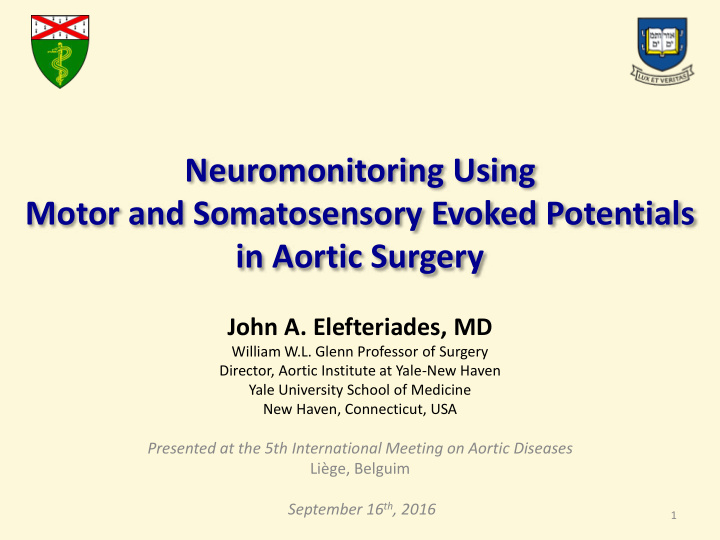



Neuromonitoring Using Motor and Somatosensory Evoked Potentials in Aortic Surgery John A. Elefteriades, MD William W.L. Glenn Professor of Surgery Director, Aortic Institute at Yale-New Haven Yale University School of Medicine New Haven, Connecticut, USA Presented at the 5th International Meeting on Aortic Diseases Liège, Belguim September 16 th , 2016 1
Paraplegia Continues • Paraplegia continues to occur, despite advances in prevention, including: - LA-FA Bypass (left heart bypass) - Spinal fluid drainage - Maintenance of high perfusion pressure - Identification/preservation of spinal artery • Complicates both types of procedures: - Open – 10% (Crawford II and III) - Endovascular – 5% 2
Incidence of paraplegia related to aortic surgery is increasing, as number of cases grows 3
Reported Rates of Paraplegia 4
Selecting an intraoperative monitoring protocol • Transcranial Motor Evoked Potentials (MEP) – Compound muscle action potentials recorded from peripheral muscles following transcranial electrical stimulation of the motor cortex – Monitors the coticospinal tracts and anterior horn motor neuron function • Somatosensory Evoked Potentials (SSEP) – Recorded over the scalp in the somatosensory cortex following electrical stimulation of peripheral nerves – Monitors the dorsal column of the spinal cord 5
MEP Technical Set Up 6
Why are MEPs necessary? 1. Anatomic separation of dorsal columns and the motor pathway 2. Distinctly different vascular supplies for the anterior and posterior spinal cord 3. Anterior spinal cord is more sensitive to ischemia due to a poorer anastomotic network than the posterior spinal cord 4. Motor gray matter in the spinal cord is more sensitive to ischemia than the dorsal column white matter axons 7
Pre-operative considerations • Patient Interview and Exam – Neuro exam – Contraindications for running MEPs – International 10-20 system head measurement • Communication with the anesthetic team – Total intravenous anesthesia preferred – Multiple train MEPs are generally obtainable with low dose of inhalation agent (<.5 MAC), however this is patient dependent. – Effects of opioids are minimal on evoked potentials – No relaxant generally preferred – MEPs can be run under controlled partial NMB 8
9
Patient profile • 78 patients with Desc/TAAA surgery • 2009-2014 period • Mean age 66 ± 12 years (range 37 – 86) • 37 female patients (47%) • Etiologies: – Aneurysm – 47 patients (60%) – Dissection – 23 patients (30%) – IMH – 4 patients (5%) – Other (PAU, etc.) – 4 patients (5%) 10
Localization of the Spinal Arteries 11
Surgical Protocol • Types of Interventions: – Open Descending Replacement – 20 (25%) – Stage 2 Elephant Trunk procedures – 24 (31%) – Open Thoracoabdominal Repair – 29 (37%) – TEVAR – 2 (3%) – Extra-anatomical Bypass – 3 (4%) • Bypass used: – Left-heart bypass – 61 (78%) – Cardiopulmonary bypass – 8 (10%) • Deep hypothermic circulatory arrest – 4 (5%) – No bypass required – 9 (12%) 12
Patient Outcomes 13
Patient Outcomes 14
Patient Outcomes 15
Specificity and Sensitivity 16
Conclusions • The use of neuromonitoring has become routine at our center. • We find neuromonitoring helpful in two ways: – First, preservation or full return of signals heralds good neurologic outcome allowing the team to ‘‘breathe easy,’’ so to speak, in those cases. – Second, failure of spinal return, while usually not followed by paraplegia, encourages us to further optimize cord perfusion (by raising blood pressure, and raising hematocrit and oxygenation). • Our experience supports the growing popularity of neuromonitoring during descending and thoracoabdominal aortic resection. 17
Recommend
More recommend